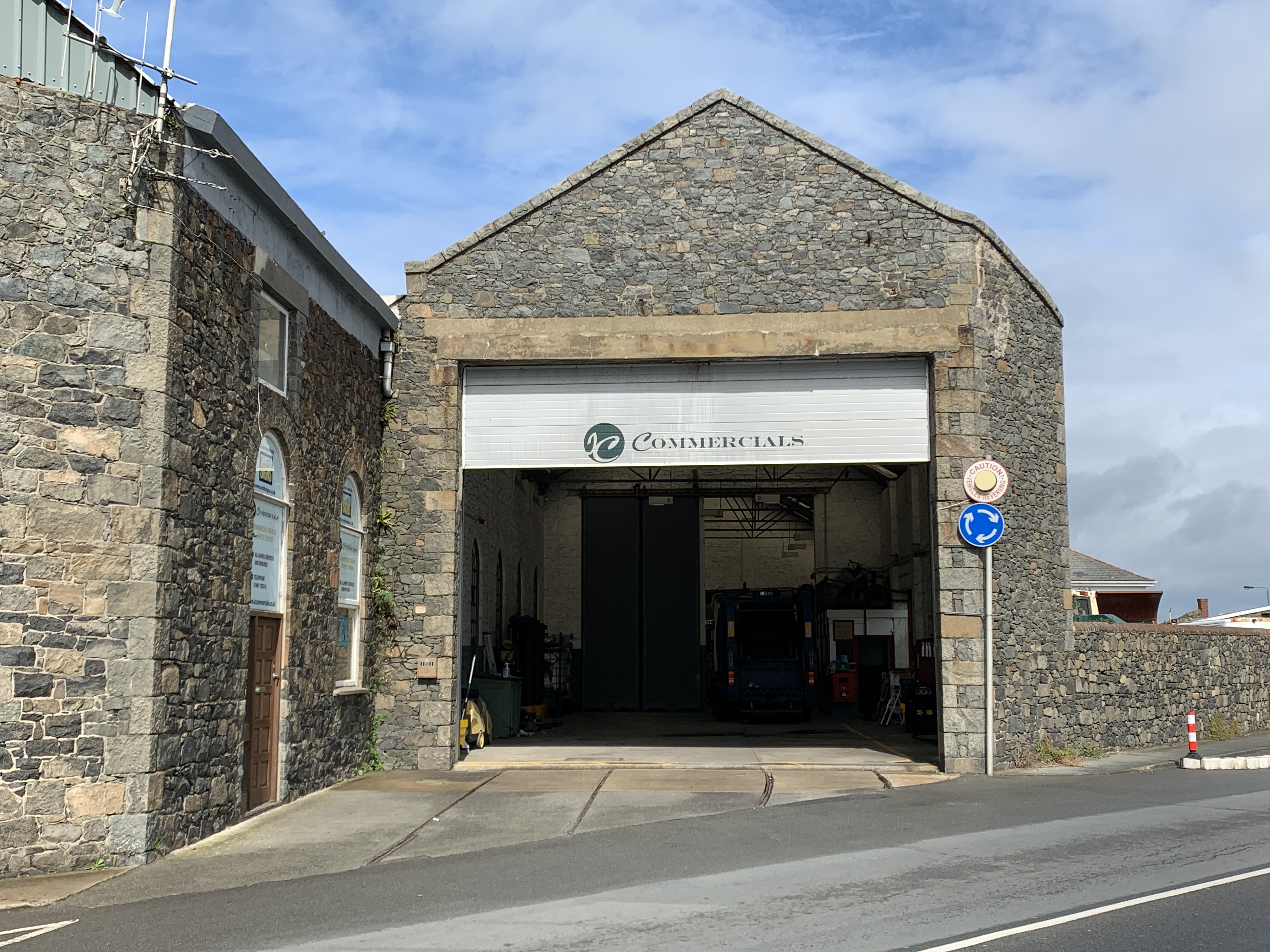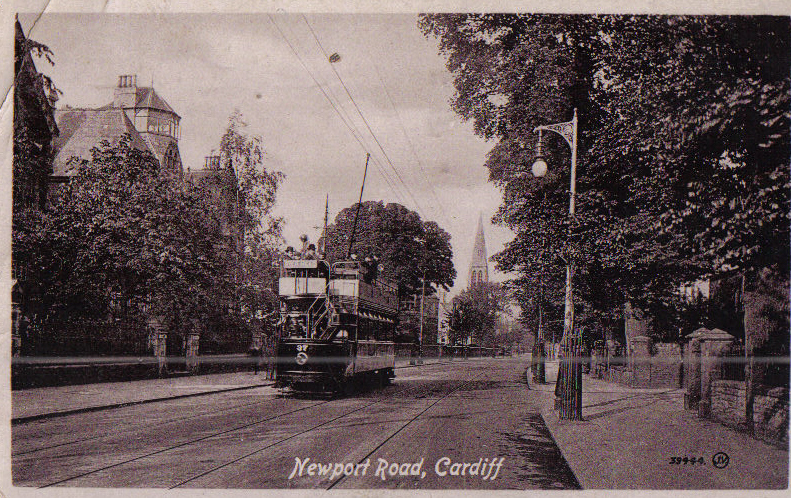|
Guernsey Railway
The Guernsey Railway opened as the Guernsey Steam Tramway on 6 June 1879 with two steam tram engines, more being added later. It was later converted to an electric tramway, which began working on 20 February 1892. The system closed on 9 June 1934. This leaves Alderney as the only Channel Island with a working railway. Guernsey Steam Tramway Company The Guernsey Steam Tramway Company was registered in London on 29 May 1878, the concession having been granted by the States of Guernsey on 2 May 1877, and confirmed by an Order in Council of 13 August 1877. The line extended for about three miles from Saint Peter Port, the principal town, to Saint Sampson's, a smaller port which at that time had extensive granite quarries. The line was single track with passing loops, with a maximum gradient of 1 in 32. The contract for construction was awarded to John Howard F.R.G.S and the value was a little over £4,000 per mile (equal to £ today). The first Merryweather steam engine ... [...More Info...] [...Related Items...] OR: [Wikipedia] [Google] [Baidu] |
Guernsey
Guernsey (; Guernésiais: ''Guernési''; french: Guernesey) is an island in the English Channel off the coast of Normandy that is part of the Bailiwick of Guernsey, a British Crown Dependency. It is the second largest of the Channel Islands, an island group roughly north of Saint-Malo and west of the Cotentin Peninsula. The jurisdiction consists of ten parishes on the island of Guernsey, three other inhabited islands ( Herm, Jethou and Lihou), and many small islets and rocks. It is not part of the United Kingdom, although defence and some aspects of international relations are managed by the UK. Although the bailiwicks of Jersey and Guernsey are often referred to collectively as the Channel Islands, the "Channel Islands" are not a constitutional or political unit. Jersey has a separate relationship to the Crown from the other Crown dependencies of Guernsey and the Isle of Man, although all are held by the monarch of the United Kingdom. The island has a mixed British-Norm ... [...More Info...] [...Related Items...] OR: [Wikipedia] [Google] [Baidu] |
Falcon Engine & Car Works
Brush Traction is a manufacturer and maintainer of railway locomotives in Loughborough, England. It is a subsidiary of Wabtec. History Hughes's Locomotive & Tramway Engine Works Henry Hughes had been operating at the Falcon Works since the 1850s, producing items such as brass and iron cast parts for portable engines and thrashing machines. In 1860 Henry Hughes announced he had entered into a partnership with William March who had extensive experience in the timber trade, and this would be added to the existing business of "engineers and manufacturers of railway plant", with the business to be called Hughes and March. In March 1863, Hughes announced it was making a steam locomotive designed for contractors and mineral railways. This was an 0-4-0 saddle tank with a 200 psi boiler pressure and cylinders of 10 inch bore and 15 inch stroke. In 1866, Hughes announced a sale of timber and associated equipment from the "Falcon Railway Plant Works" as he had decided to close down ... [...More Info...] [...Related Items...] OR: [Wikipedia] [Google] [Baidu] |
Railway Lines In The Channel Islands
Rail transport (also known as train transport) is a means of transport that transfers passengers and goods on wheeled vehicles running on rails, which are incorporated in tracks. In contrast to road transport, where the vehicles run on a prepared flat surface, rail vehicles (rolling stock) are directionally guided by the tracks on which they run. Tracks usually consist of steel rails, installed on sleepers (ties) set in ballast, on which the rolling stock, usually fitted with metal wheels, moves. Other variations are also possible, such as "slab track", in which the rails are fastened to a concrete foundation resting on a prepared subsurface. Rolling stock in a rail transport system generally encounters lower frictional resistance than rubber-tyred road vehicles, so passenger and freight cars (carriages and wagons) can be coupled into longer trains. The operation is carried out by a railway company, providing transport between train stations or freight customer faciliti ... [...More Info...] [...Related Items...] OR: [Wikipedia] [Google] [Baidu] |
Transport In Guernsey
Guernsey is the second largest of the Channel Islands. It is part of the Common Travel Area, allowing passport-free travel to and from the United Kingdom or Jersey. Travel to and from mainland Europe requires a passport or an EU national identity document. Non EU citizens may need a visa. This article includes some references to Alderney and Sark, which are part of the Bailiwick of Guernsey. Road transport Traffic in Guernsey drives on the left. Roads are generally narrow, with an all-island speed limit of , however lower speed limits apply on certain roads. Motor tax was abolished in Guernsey from 1 January 2008. There are seven taxi ranks in St Peter Port. Vehicle registration plates in Guernsey carry between one and five numerals only; the international identification sticker/plate is "GBG". Most road markings are the same as the UK, with the exception of: * A yellow line across the exit of a minor road means stop and give way to traffic on the major road. A yellow arrow ... [...More Info...] [...Related Items...] OR: [Wikipedia] [Google] [Baidu] |
List Of Channel Islands Railways
List of Channel Islands railways: * Alderney Railway (working) * Guernsey Railway (closed) * Jersey Railway (closed) * Jersey Eastern Railway (closed) References * {{DEFAULTSORT:Channel Islands railways Channel Islands The Channel Islands ( nrf, Îles d'la Manche; french: îles Anglo-Normandes or ''îles de la Manche'') are an archipelago in the English Channel, off the French coast of Normandy. They include two Crown Dependencies: the Bailiwick of Jersey, ... Rail transport in the Channel Islands ... [...More Info...] [...Related Items...] OR: [Wikipedia] [Google] [Baidu] |
Cardiff Corporation Tramways
Cardiff Corporation Tramways was a company that operated an electric tramway service in Cardiff between 1902 and 1950. History Horse trams had run in the city from 1872 until 1904. The first tram route ran from High Street in the city centre to the Docks run by the Cardiff Tramway Company. In 1898, Cardiff County Borough Council obtained Parliamentary powers to take over all the tramways in the area, and to use new electric trams, owning them from 1903. The routes formally opened on 1 May 1902. Electricity was supplied from the Cardiff power station at Roath adjacent to the tram depot. In 1904, more than 23 million passengers had been carried in that year, up from 18 million the previous year. and when Cardiff became a city in 1905, 131 electric trams were operating on the network, mainly focusing on the busy Cardiff Docks. The Corporation also operated a city-wide parcel delivery service. The Hayes Island Snack Bar was built in 1911 as the main parcel depot and functioned u ... [...More Info...] [...Related Items...] OR: [Wikipedia] [Google] [Baidu] |
First World War
World War I (28 July 1914 11 November 1918), often abbreviated as WWI, was one of the deadliest global conflicts in history. Belligerents included much of Europe, the Russian Empire, the United States, and the Ottoman Empire, with fighting occurring throughout Europe, the Middle East, Africa, the Pacific, and parts of Asia. An estimated 9 million soldiers were killed in combat, plus another 23 million wounded, while 5 million civilians died as a result of military action, hunger, and disease. Millions more died in genocides within the Ottoman Empire and in the 1918 influenza pandemic, which was exacerbated by the movement of combatants during the war. Prior to 1914, the European great powers were divided between the Triple Entente (comprising France, Russia, and Britain) and the Triple Alliance (containing Germany, Austria-Hungary, and Italy). Tensions in the Balkans came to a head on 28 June 1914, following the assassination of Archduke Franz Ferdina ... [...More Info...] [...Related Items...] OR: [Wikipedia] [Google] [Baidu] |
Worthington Pump
The Worthington Corporation was a diversified American manufacturer that had its roots in Worthington and Baker, a steam pump manufacturer founded in 1845. In 1967 it merged with Studebaker and Wagner Electric to form Studebaker-Worthington. This company was in turn acquired by McGraw-Edison in 1979. Worthington Pump Works (1845–1899) Worthington and Baker, manufacturers of hydraulic machinery such as steam pumps and meters, was founded by Henry R Worthington and William H. Baker. Worthington was the inventor of the direct acting steam pump. The first foundry was near the Brooklyn Navy Yard. In 1854 the partners moved to Van Brunt Street in Brooklyn. The partnership was dissolved around 1860 when Baker died. A new partnership called Henry R. Worthington, or Worthington Hydraulic Pump Works, was formed in 1862. The United States Navy used Worthington pumps to pump: boiler feed water, bilge water, fire fighting, and general services (https://www.asme.org/about-asme/engineeri ... [...More Info...] [...Related Items...] OR: [Wikipedia] [Google] [Baidu] |
Guernsey Railway Depot
Guernsey (; Guernésiais: ''Guernési''; french: Guernesey) is an island in the English Channel off the coast of Normandy that is part of the Bailiwick of Guernsey, a British Crown Dependency. It is the second largest of the Channel Islands, an island group roughly north of Saint-Malo and west of the Cotentin Peninsula. The jurisdiction consists of ten parishes on the island of Guernsey, three other inhabited islands (Herm, Jethou and Lihou), and many small islets and rocks. It is not part of the United Kingdom, although defence and some aspects of international relations are managed by the UK. Although the bailiwicks of Jersey and Guernsey are often referred to collectively as the Channel Islands, the "Channel Islands" are not a constitutional or political unit. Jersey has a separate relationship to the Crown from the other Crown dependencies of Guernsey and the Isle of Man, although all are held by the monarch of the United Kingdom. The island has a mixed British-Norma ... [...More Info...] [...Related Items...] OR: [Wikipedia] [Google] [Baidu] |






